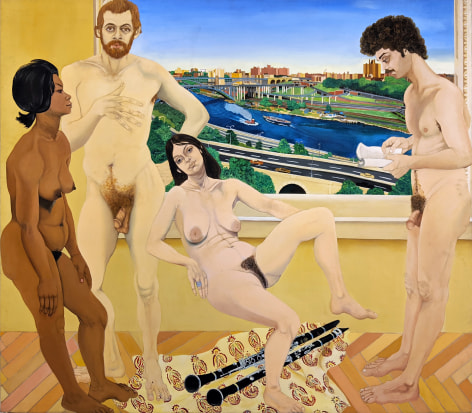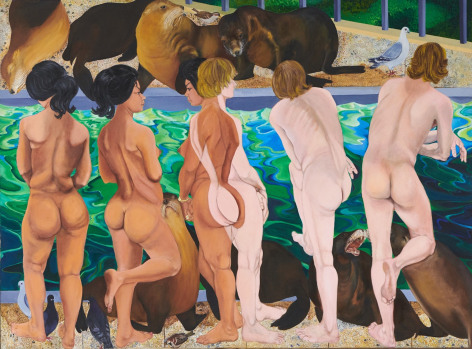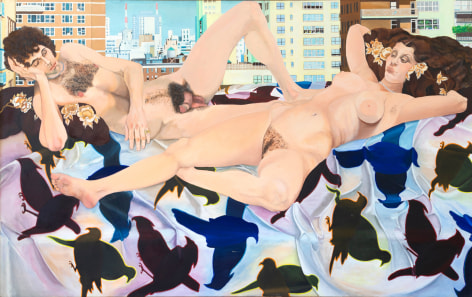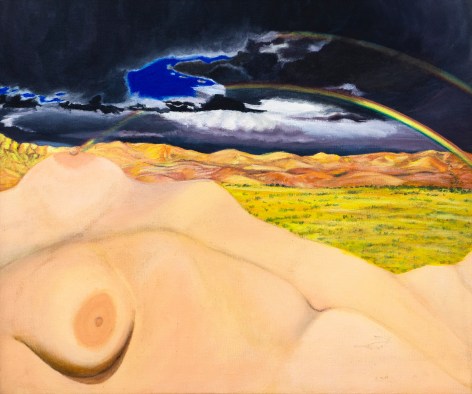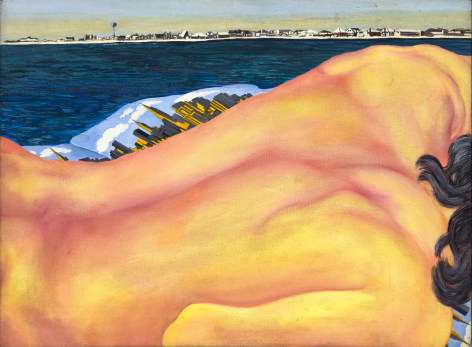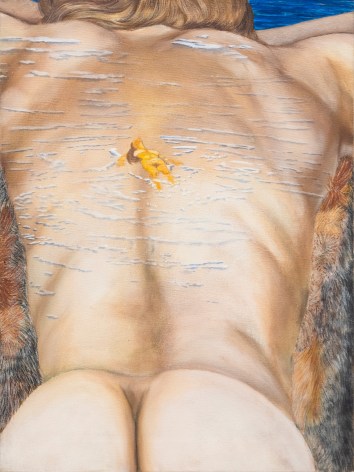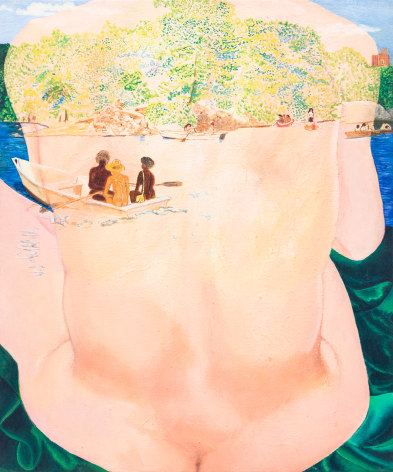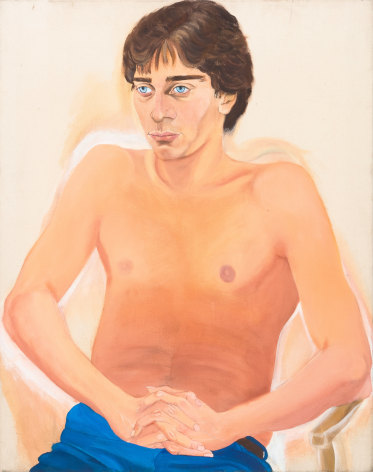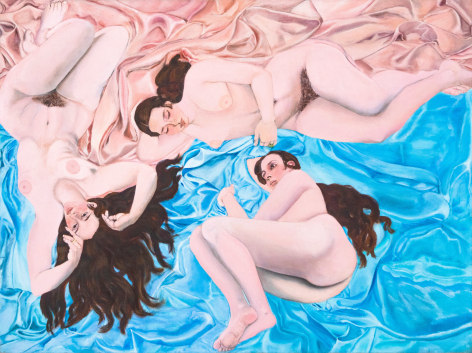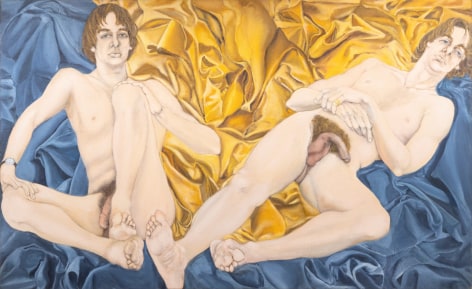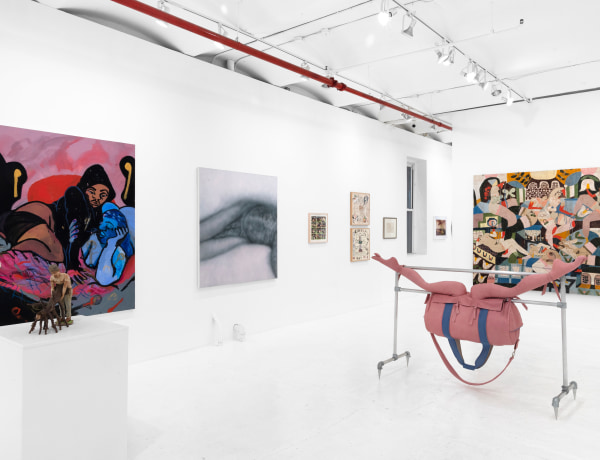
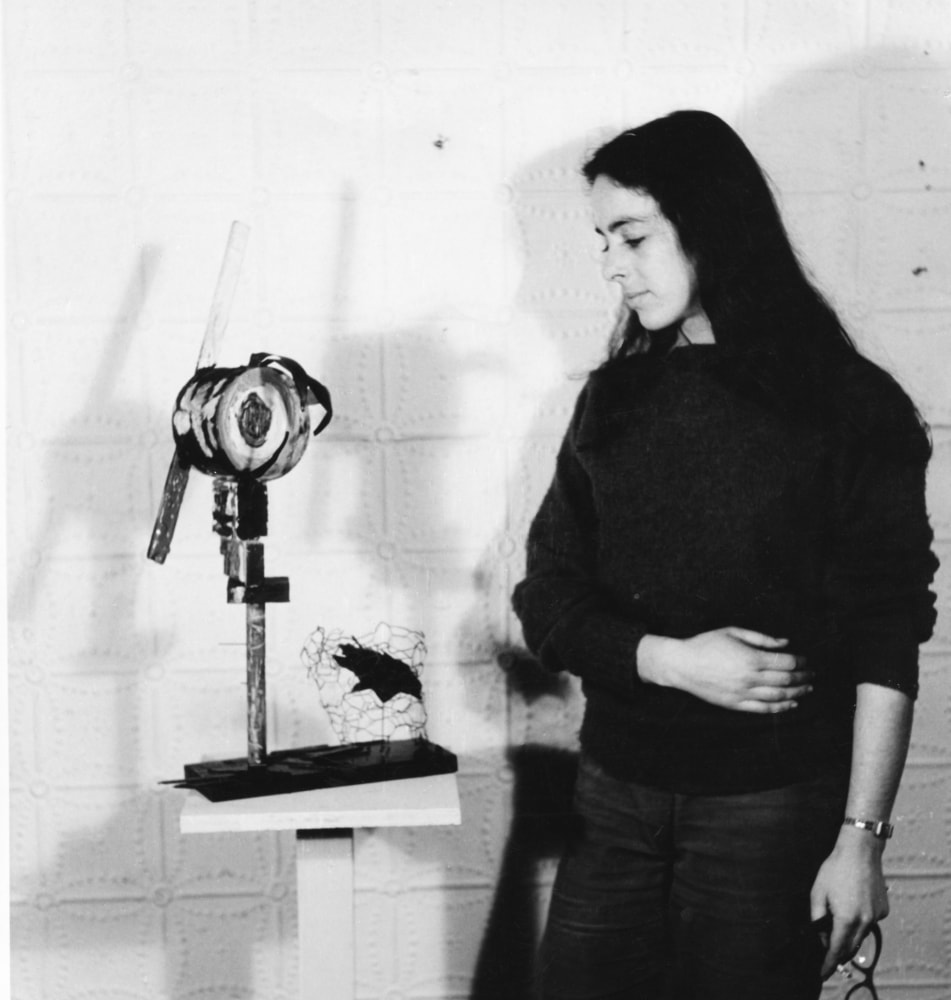
B. NEW YORK, NEW YORK, 1931
Martha Edelheit is a pioneering feminist artist whose work confronts dominant art historical paradigms, foregrounding female gaze and desire. Known for eroticism, her lush and vivid work is at once critical, sensual, and humorous. Edelheit was born in New York City in 1931, where she lived until moving to Sweden in 1993. An important voice for feminist art, she is known for both her frank depictions of sexuality and her insistence on their place within an art historical tradition and society.
Edelheit studied at the University of Chicago, New York University, and Columbia University in the 1950s. She studied with artist Michael Loew and art historian Meyer Schapiro, who Edelheit credits with inspiring a new way of thinking about image construction and pictorial space.
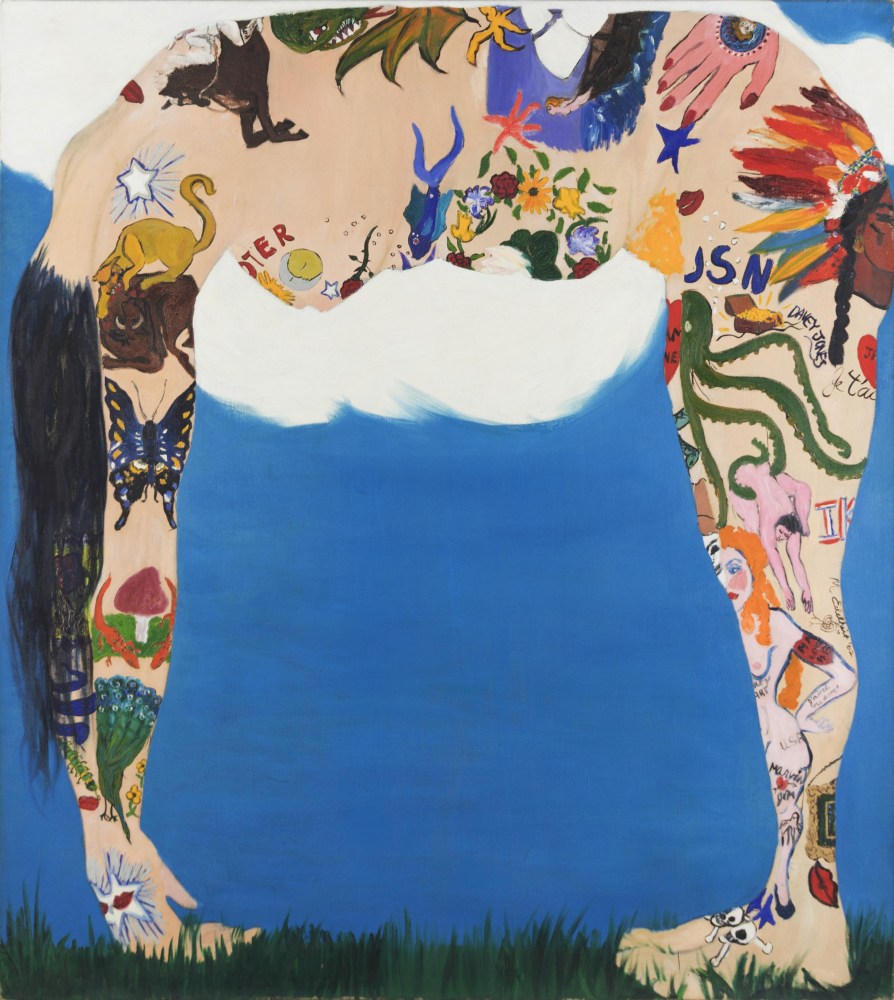
Martha Edelheit
Tattooed Lady, 1962
oil on canvas
45h x 50w x 1 1/2d in
114.30h x 127w x 3.81d cm
MEDE001
Edelheit established herself in the center of the downtown avant-garde, becoming a member of the Tenth Street artist-run space, the Reuben Gallery, where her first solo show was held in 1960. She, like other members Jim Dine, Rosalyn Drexler, Allan Kaprow, Claes Oldenberg, Lucas Samaras, and Robert Whitman, were expanding the definitions of art-making with the creation of Happenings and experimental objects. At the Reuben Gallery, Edelheit first exhibited her “extension” paintings which break the frame of the work and utilize utilitarian objects. They combine impasto paint and found materials into irregularly shaped constructions. In her work from the 1960s, she addresses female desire, the body, and skin as an alternate “canvas” for tattoo imagery.
By the early 1970s, Edelheit began to work with the combination of nude figures, photographs and memory. She was interested in “montage”—this combination of elements and even figures who didn’t necessarily pose together. She was exploring what was integral to establish the space and how symbols could become signifiers of the inner life of her models. By this period, Edelheit became more involved in the Women’s Art Movement at large as an activist and art worker. She was a member of Fight Censorship, alongside other women artists foregrounding eroticism, including Joan Semmel, Judith Bernstein, and Hannah Wilke. She was also involved with The Women’s Caucus for Art, the Women’s Institute for Freedom of the Press, and other feminist initiatives.
Edelheit has always been particularly interested in circus performers and the way in which they can contort and manipulate their bodies. As a child, she was a fan of the circus and later she became a gymnast with the hopes of being able to move in the way that these performers could. Circus performers have recurred in her work since the 1960s. In this work, Edelheit explores the fleshy geometries of the circus through a series of figures that balance precariously on each other or leap through the air. All the while, contortions and costuming suggest sadomasochistic play. Edelheit’s work has been included in museum exhibitions internationally, including Kunsthalle Bielefeld, Germany; Foundation Vincent Van Gogh, Arles, France; the Jewish Museum, New York, among others. Her work is in the collections of the Minneapolis Institute of Art, Minnesota and Moderna Museet, Stockholm, Sweden, among others. Edelheit’s work will be featured in the 2025 exhibition Sixties Surreal at the Whitney Museum of American Art.
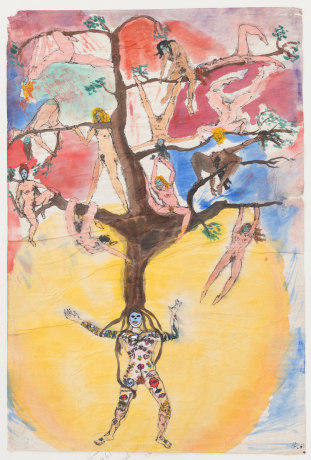
The Way I See It: Selections from the KAWS Collection features more than 350 artworks chosen by KAWS from his vast personal collection of over 3,000 works on paper by some 500 artists. The Way I See It continues The Drawing Center’s tradition of exhibiting drawings from outstanding public and private collections, and offers an unprecedented glimpse into the artistic inspirations and interests of one of today’s most popular contemporary artists.
The Church’s summer 2024 exhibition considers humor and contemporary art, focusing solely on the work of female-identifying artists. Conceived and organized by Chief Curator Sara Cochran, it features the work of 40 artists across all media installed across The Church’s Main Floor and the Mezzanine.
With Talk Art Podcast, KAWS aka Brian Donnelly discusses his three major institutional exhibitions all opening in 2024. The first show has just opened at The Andy Warhol Museum, Pittsburgh and is the first time that Donnelly's work has been aligned with Warhol. Followed by the Parrish Art Museum this summer, and The Drawing Center, set to open in Autumn.
Blum & Poe, Los Angeles is pleased to present “Pictures Girls Make”: Portraitures, an exhibition bringing together over fifty artists from around the world, spanning the early nineteenth century until today. Curated by Alison M. Gingeras, this prodigious survey argues that this age-old mode of representation is an enduringly democratic, humanistic genre.
In Martha Edelheit’s groovy scenes of erotic languor—featuring nudes in unselfconscious poses with intent or with distant facial expressions, usually basking in the sun—the pulsing undercurrent of optimism is most seductive. That, and the THC-Technicolor extravagance of her realist style. The ninety-one-year-old artist’s exhibition here, Naked City, Paintings from 1965–1980 which included several monumentally scaled works, spanned a period of social upheaval, when the artist labored with visionary feminist vigor. She rendered slack dicks and unidealized bodies in detail, holding the sexual revolution to its word in the realm of painting.
[Edelheit’s] figures achieve true transcendence in the real space of the city. . . . The frisson of a rippling deltoid foregrounding the unloveliness of crumbling infrastructure, as in “Major Deegan Expressway With Fruit” (1972-73), both sends up Western traditions and refreshes them.
For Edelheit, the city’s built environment is as spiritually revelatory as any desert. Bodies rendered in creamy pastels merge into a single mass before the seal enclosure, or dissolve into Central Park’s lake, becoming the landscape itself, a poetic depiction of art’s fundamental indispensability from life.
The wrenching, spiky and jagged forms in Martha Edelheit’s Sacrificial Portrait, and the frightening red and white gestures exploding against black in Sonia Gechtoff’s work, have all the attack and suddenness of a punch in the face. Corinne West, meanwhile, resorted to painting under the name Michael West. George (Grace) Hartigan and Lee Krasner, whose name was originally Lena, also felt it necessary to disguise their gender. It is no wonder women get angry.
Your list of must-see, fun, insightful, and very New York art events this month, including Ed Ruscha, Nina Katchadourian, Luis Camnitzer, Martha Edelheit, and more.
I am rooting for Martie Edelheit.
At the age of 91, she’s finally emerging from years of obscurity. Her mind is clear and her body agile enough to enjoy every small step of it all—a bustling opening, a post-opening dinner at the fashionable restaurant Il Buco—while leaning on a cane, or a friend’s arm. Small, fierce, outspoken, Martha Edelheit keeps pushing forward, with new 11-foot paintings and a planned return to New York City, her hometown.
I first encountered Edelheit in the context of another story, which explored the asymmetry of market acclaim for female artists based on the findings of the Burns Halperin Report.
As I wrote in December: “The overwhelming majority of women, especially women of a certain age, are ghosts as far as auction sales go. The reasons for this vary, from the market’s preference for painting over conceptual and performance art to lack of access to the gallery system to individual choices to slow artistic production during child-rearing years.”
The auction market for Pablo Picasso is larger than that for all female artists over the past 14 years.
Walls of flesh, walls of skin. I meet this at Galleri Larsen/ Warner, where I am overwhelmed by Marta Edelheit's paintings from the 1960s and 70s. Edelheit has lived in Sweden since the 1990s, but during the previously mentioned decades she was in the middle of the action, in New York's avant-garde art scene, in the city where she herself was born and worked for many years. Works from this period are now displayed in two small gallery rooms on bstermalm in what is Edelheit's first exhibition in Stockholm in a couple of decades. Sometimes her naked bodies are close, completely enlarged in a way that almost obscures what you look at: from the lines of the small pastel drawings, zoomed in almost abstraction, you can read the volume of a thigh, the folds of the vulva, the roundness of the buttocks. The color scale is strong, you could call it psychedelic, but I prefer to call it fruity: together with the more skin-friendly tones of peach, blushing inside, blue and green and yellow are found. A milky pink nipple is paired with the colors of an overripe banana. Edelheit's color management is phenomenal. In the drawings, it appears to be both inviting, tempting and a little repulsive.
Eyes that are sometimes closed, like closed in a sweet intoxication, sometimes turned away, sometimes angled straight towards the viewer. It is only when elements of voyeurism affect one. As in A View of Lake Atitian (1973) where the nickel-yellow woman in the armchair locks her eyes in one. In the other paintings, the painted ones are rather enclosed in themselves. In the kaleidoscope -linking form where the same person reappears at different angles on the same painting, a dreamlike dimension is added to these enchanted portraits.
Figurative paintings by three Americans reflect the shifting social and sexual mores of the nineteen-sixties and seventies in this wonderful show, whose title is borrowed from a 1962 essay by Dore Ashton.
This amazing Noho gallery is lighting up the past with the enormous “flesh wall” paintings of Martha Edelheit. Born in New York in 1931, she is still painting and, judging from what’s here, has one of the most mysteriously erotic-hot inner lives of any painter of the 1960s. Witness lounging female and male bodies and men with enormous erections performing acrobatics for women.
Martha Edelheit is yet another indication that 20th-century art history is still under construction, with large areas unfinished or invisible. Ms. Edelheit was included in last year’s “Inventing Downtown: Artist-Run Galleries in New York City, 1952-1965” at the Grey Art Gallery, which featured several artists unfamiliar to wider audiences. Now “Flesh Walls: Tales From the 60s” at Eric Firestone is devoted to Ms. Edelheit’s work from that era. She was part of the downtown, artist-run Reuben Gallery, where she had her first solo show in 1960. The “Flesh Walls” title is not metaphorical or accidental. Ms. Edelheit’s meaty, sexy paintings and drawings iterate tales of the sexually permissive ’60s. She approached the human body through the skin, inspired initially by the writings of the anthropologist Claude LeviStrauss, who suggested that the body was the original canvas for painting, in the form of tattoos.
Whitechapel Gallery presents a major exhibition of 150 paintings from an overlooked generation of 81 international women artists.

